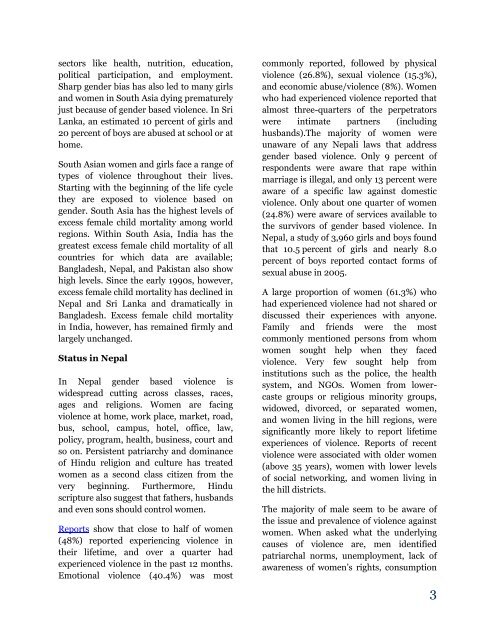GENDER BASED VIOLENCE
Backgrounder%20on%20Gender%20Based%20Violence
Backgrounder%20on%20Gender%20Based%20Violence
You also want an ePaper? Increase the reach of your titles
YUMPU automatically turns print PDFs into web optimized ePapers that Google loves.
sectors like health, nutrition, education,<br />
political participation, and employment.<br />
Sharp gender bias has also led to many girls<br />
and women in South Asia dying prematurely<br />
just because of gender based violence. In Sri<br />
Lanka, an estimated 10 percent of girls and<br />
20 percent of boys are abused at school or at<br />
home.<br />
South Asian women and girls face a range of<br />
types of violence throughout their lives.<br />
Starting with the beginning of the life cycle<br />
they are exposed to violence based on<br />
gender. South Asia has the highest levels of<br />
excess female child mortality among world<br />
regions. Within South Asia, India has the<br />
greatest excess female child mortality of all<br />
countries for which data are available;<br />
Bangladesh, Nepal, and Pakistan also show<br />
high levels. Since the early 1990s, however,<br />
excess female child mortality has declined in<br />
Nepal and Sri Lanka and dramatically in<br />
Bangladesh. Excess female child mortality<br />
in India, however, has remained firmly and<br />
largely unchanged.<br />
Status in Nepal<br />
In Nepal gender based violence is<br />
widespread cutting across classes, races,<br />
ages and religions. Women are facing<br />
violence at home, work place, market, road,<br />
bus, school, campus, hotel, office, law,<br />
policy, program, health, business, court and<br />
so on. Persistent patriarchy and dominance<br />
of Hindu religion and culture has treated<br />
women as a second class citizen from the<br />
very beginning. Furthermore, Hindu<br />
scripture also suggest that fathers, husbands<br />
and even sons should control women.<br />
Reports show that close to half of women<br />
(48%) reported experiencing violence in<br />
their lifetime, and over a quarter had<br />
experienced violence in the past 12 months.<br />
Emotional violence (40.4%) was most<br />
commonly reported, followed by physical<br />
violence (26.8%), sexual violence (15.3%),<br />
and economic abuse/violence (8%). Women<br />
who had experienced violence reported that<br />
almost three-quarters of the perpetrators<br />
were intimate partners (including<br />
husbands).The majority of women were<br />
unaware of any Nepali laws that address<br />
gender based violence. Only 9 percent of<br />
respondents were aware that rape within<br />
marriage is illegal, and only 13 percent were<br />
aware of a specific law against domestic<br />
violence. Only about one quarter of women<br />
(24.8%) were aware of services available to<br />
the survivors of gender based violence. In<br />
Nepal, a study of 3,960 girls and boys found<br />
that 10.5 percent of girls and nearly 8.0<br />
percent of boys reported contact forms of<br />
sexual abuse in 2005.<br />
A large proportion of women (61.3%) who<br />
had experienced violence had not shared or<br />
discussed their experiences with anyone.<br />
Family and friends were the most<br />
commonly mentioned persons from whom<br />
women sought help when they faced<br />
violence. Very few sought help from<br />
institutions such as the police, the health<br />
system, and NGOs. Women from lowercaste<br />
groups or religious minority groups,<br />
widowed, divorced, or separated women,<br />
and women living in the hill regions, were<br />
significantly more likely to report lifetime<br />
experiences of violence. Reports of recent<br />
violence were associated with older women<br />
(above 35 years), women with lower levels<br />
of social networking, and women living in<br />
the hill districts.<br />
The majority of male seem to be aware of<br />
the issue and prevalence of violence against<br />
women. When asked what the underlying<br />
causes of violence are, men identified<br />
patriarchal norms, unemployment, lack of<br />
awareness of women’s rights, consumption<br />
3


